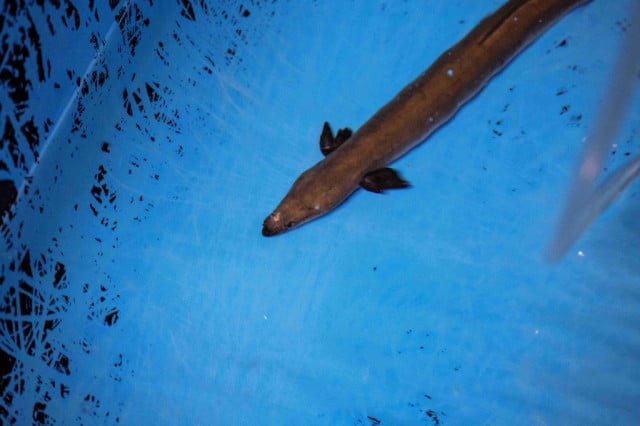70 million years on earth, 40 years of decline: the endangered eel

- By Agence France-Presse (AFP)
- December 14, 2021 9:34 AM
Tokyo, Japan | Eels were once so abundant that they were considered a pest, but today the ancient creature is threatened by human activity and risks disappearing altogether, scientists and environmentalists warn.
How have eel populations changed?
Eels appear in human mythology and ancient art, and their bones have been found in tombs dating back thousands of years.
Just thirty years ago, they were so common that in France they were even classed a nuisance, accused of damaging salmon stock and destroying fishing lines.
"When I was young, eels were in every river and estuary," said French researcher Eric Feunteun, a leading expert on the creature.
"My grandmother had a cafe... and sometimes customers who were down on their luck would bring a bucket of young eel to pay for their coffee," he said.
In less than half a century, the situation has changed radically: the European eel's population is now just 10 percent of its 1960-70s level.
"We sounded the alarm in the 1980s," explained Feunteun, a marine ecology professor at France's National Museum of Natural History, but it wasn't until 2007 that the European Union required its members to protect the species.
The European eel now appears on the International Union for Conservation of Nature's critically endangered list, with its Japanese and American cousins just one category behind, on the endangered list.
What threatens eel populations?
The eel's complex life cycle makes it vulnerable to a wide range of human activity, including overfishing of a species that is a much-loved delicacy in Asia.
But that pressure is far from the only thing driving eel decline.
"We've known since the 1980s that there are multiple reasons and that fishing probably isn't the main factor," said Feunteun.
He points out that polluting waterways with contaminants like pesticides, medicines and plasticisers has a much greater effect, including on eels' reproductive capacity.
Habitat destruction also plays a significant role, according to Andrew Kerr, president of the Sustainable Eel Group.
He points to the "draining of three quarters of the wetlands of Europe. And then the one million plus barriers to fish migration in the rivers, like dams."
"So we basically destroyed the eel's habitat. And that's what's really killed it off," he told AFP.
Climate change is also a factor, shifting marine currents that carry eels from their spawning grounds in tropical waters to the rivers and estuaries where they will spend most of their lives.
Longer and slower routes mean higher mortality rates for young eels as they drift towards coastlines.
How are eels being protected?
Since 2012, Japan, China, Taiwan and South Korea have cooperated on conserving the Japanese eel found in their waters, including with fishing quotas.
But fishing limits alone are insufficient, experts say.
Other efforts include programmes that range from helping eels over migration barriers, to moving young eels from areas where they are abundant to places where they are in decline.
Elsewhere, dams that can trap, injure and kill eels as they migrate have been adapted, and systems to trace them and interrupt trafficking have also been introduced.
More is needed though, experts say, including on habitat protection.
"It won't take long for the other 16 species of eels to get on the endangered list. So we have to have a global approach to safeguarding the eel," said Kerr.
What about artificial reproduction?
The eel has proved resistant to reproducing naturally in captivity and artificial fertilisation is possible but expensive.
"The reproductive rate is low and it takes a long time for the (juvenile) glass eels to grow," said Ryusuke Sudo of the Japan Fisheries Research and Education Agency in the Izu region, southwest of Tokyo.
Scientists have also never observed eel larvae eating in the wild, so their preferred food remains a mystery. They grow slower in captivity and each eel requires individual human intervention to reproduce.
Could the eel disappear?
Eels are believed to have been around for 60-70 million years, and have not diversified much, with just 19 species and subspecies in the Anguilla genus.
For all their longevity, much about them remains a mystery, with scientists only recently pinpointing the first spawning grounds.
In some ways, eels are "super-adapted", said Feunteun. They are able to breed in areas where most fish could not find food, because eel young can feed on "marine snow", dead and decaying plant and animal matter that drifts down the water column.
But the long distances they migrate and disperse leave them vulnerable.
"Seventy million years of existence and 40 years of decline," as Feunteun puts it.
Still, he holds out some hope.
"It's a species that has shown during previous climatic changes that it can rebound from very few individuals," he said.
© Agence France-Presse















